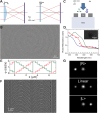Computing metasurfaces for all-optical image processing: a brief review
- PMID: 39635069
- PMCID: PMC11501308
- DOI: 10.1515/nanoph-2021-0823
Computing metasurfaces for all-optical image processing: a brief review
Abstract
Computing metasurfaces are two-dimensional artificial nanostructures capable of performing mathematical operations on the input electromagnetic field, including its amplitude, phase, polarization, and frequency distributions. Rapid progress in the development of computing metasurfaces provide exceptional abilities for all-optical image processing, including the edge-enhanced imaging, which opens a broad range of novel and superior applications for real-time pattern recognition. In this paper, we review recent progress in the emerging field of computing metasurfaces for all-optical image processing, focusing on innovative and promising applications in optical analog operations, image processing, microscopy imaging, and quantum imaging.
Keywords: all-optical image processing; computing metasurface; edge detection; microscopy imaging; optical differential operation; quantum imaging.
© 2022 Shanshan He et al., published by De Gruyter, Berlin/Boston.
Figures












References
-
- Barakat R. Determination of the optical transfer function directly from the edge spread function. J. Opt. Soc. Am. . 1965;55:1217–1221. doi: 10.1364/josa.55.001217. - DOI
-
- Goodman J. W. Introduction to Fourier Optics . Colorado: Roberts and Company Publishers; 2005.
-
- Okugawa T., Hotate K. Real-time optical image processing by synthesis of the coherence function using real-time holography. IEEE Photon. Technol. Lett. . 1996;8:257–259. doi: 10.1109/68.484259. - DOI
Publication types
LinkOut - more resources
Full Text Sources
